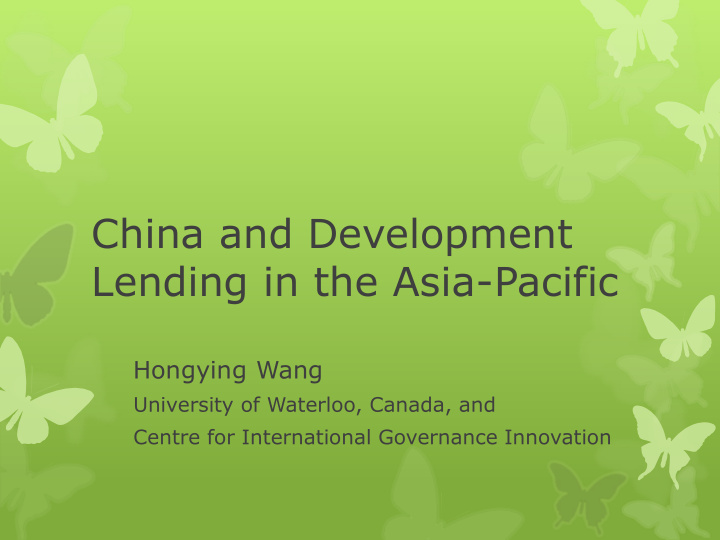



China and Development Lending in the Asia-Pacific Hongying Wang University of Waterloo, Canada, and Centre for International Governance Innovation
Outline Chinese approach to development finance The case of One Belt One Road (OBOR) China-led multilateral development banks (MDBs) Asian Infrastructure Bank (AIIB) New Development Bank (NDB) Relationship between with traditional MDBs Potential challenges
Chinese Approach to Development Finance Mutual benefit Not only ODA types (grants, interest-free loans, concessional loans), but also export credit, non- concessional loans including resource-backed loans, many aiming to promote China’s “going out” strategy “No - strings attached” “China is willing to share its development experience with all the rest of the world, but we will not intervene into other nation’s internal affairs, export our social system and development model, nor force others to accept them .” (President Xi Jinping, May 2017) Attractive to many but potentially in conflict with traditional development finance
One Belt One Road Proposed by Xi Jinping in Lots of money 2013 Silk Road Fund ($40 Focus on infrastructure billion) 65 countries to host State-owned banks OBOR projects OBOR projects ($82 billion 2015) Additional funds through Silk Road Fund, China Development Bank, Export and Import Bank of China ($113 billion promised in 2017) Some of AIIB and NDB investment Economist.com
AIIB Launched in 2016 ($100 billion) Investment made or approved in 2016 ($1.7 billion) Power project in Bangladesh ($165 million) Slum upgrading in Indonesia ($216.5 million) Road improvement in Tajikistan ($27.5 million) Motorway in Pakistan ($100 million) Hydropower project in Pakistan ($300 million) Power plant in Myanmar ($20 million) Maritime infrastructure in Oman ($301 million) Trans-Anatolian gas pipeline ($600 million)
NDB Launched in 2015 ($50 billion) Investment in 2016 ($1.5 billion) Renewable energy in China: $379 million Renewable energy in Russia: $100 million Roads and renewable energy in India: $700 million Renewable energy in Brazil: $300 million Renewable energy in S. Africa: $180 million
Complementing Traditional MDBs Infrastructure financing gap Keeping Asian development momentum requires $1.7 trillion/year in infrastructure (ADB estimate) Actual investment: $881 billion/year Gap: more than $800 billion /year Limited capacity and interest (until recently) of traditional MDBs MDBs contribute 2.5% of infrastructure investment in developing Asia (ADB estimate)
Cooperating with Other MDBs Consensus among Collaboration framework emerging and between new and old established powers MDBs Infrastructure critical for AIIB and NDB’s MOUs global economic growth and agreements with and integration ADB and World Bank Importance of public Co-financing projects private partnerships Most of AIIB’s initial New initiatives: G20 projects Global Infrastructure Initiative/Hub, World Possibility for NDB later Bank’s Global Infrastructure Facility, regional infrastructure programs…
Potential Challenges Environmental and social sustainability No strings attached and limited external pressure Mega infrastructure projects in ecologically sensitive areas not carefully evaluated for environmental impact Lack of transparency and respect of rights in countries governed by authoritarian regimes Financial sustainability China’s own infrastructure investment often involves significant waste (Oxford U. study) $1.2 billion seaport in Sri Lanka (financial loss Chinese takeover local protest) OBOR investment down in 2016 and 2017 ( Financial Times )
Thank you!
Recommend
More recommend